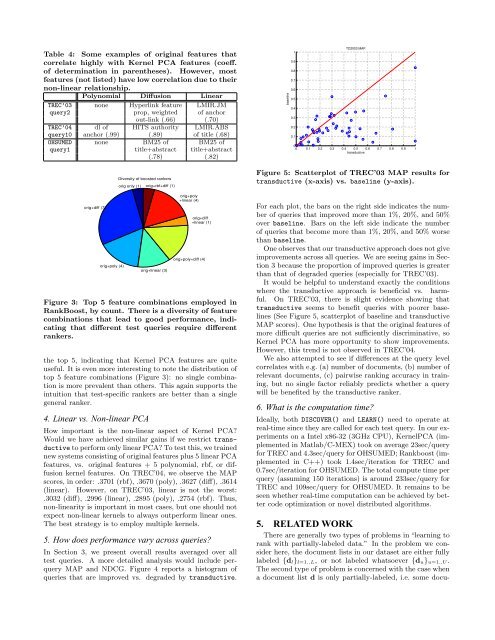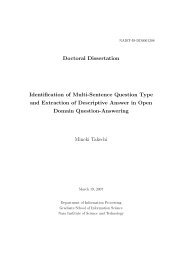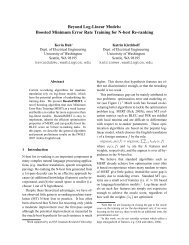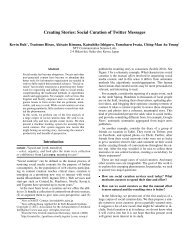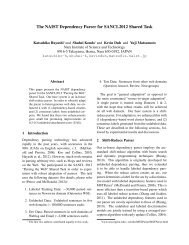Learning to Rank with Partially-Labeled Data - University of ...
Learning to Rank with Partially-Labeled Data - University of ...
Learning to Rank with Partially-Labeled Data - University of ...
Create successful ePaper yourself
Turn your PDF publications into a flip-book with our unique Google optimized e-Paper software.
Table 4: Some examples <strong>of</strong> original features that<br />
correlate highly <strong>with</strong> Kernel PCA features (coeff.<br />
<strong>of</strong> determination in parentheses). However, most<br />
features (not listed) have low correlation due <strong>to</strong> their<br />
non-linear relationship.<br />
Polynomial Diffusion Linear<br />
TREC’03 none Hyperlink feature LMIR.JM<br />
query2 prop, weighted <strong>of</strong> anchor<br />
out-link (.66) (.70)<br />
TREC’04 dl <strong>of</strong> HITS authority LMIR.ABS<br />
query10 anchor (.99) (.89) <strong>of</strong> title (.68)<br />
OHSUMED none BM25 <strong>of</strong> BM25 <strong>of</strong><br />
query1 title+abstract title+abstract<br />
(.78) (.82)<br />
orig+diff (7)<br />
orig+poly (4)<br />
Diversity <strong>of</strong> boosted rankers<br />
orig only (1)<br />
orig+rbf+diff (1)<br />
orig+linear (3)<br />
orig+poly<br />
+linear (4)<br />
orig+diff<br />
+linear (1)<br />
orig+poly+diff (4)<br />
Figure 3: Top 5 feature combinations employed in<br />
<strong>Rank</strong>Boost, by count. There is a diversity <strong>of</strong> feature<br />
combinations that lead <strong>to</strong> good performance, indicating<br />
that different test queries require different<br />
rankers.<br />
the <strong>to</strong>p 5, indicating that Kernel PCA features are quite<br />
useful. It is even more interesting <strong>to</strong> note the distribution <strong>of</strong><br />
<strong>to</strong>p 5 feature combinations (Figure 3): no single combination<br />
is more prevalent than others. This again supports the<br />
intuition that test-specific rankers are better than a single<br />
general ranker.<br />
4. Linear vs. Non-linear PCA<br />
How important is the non-linear aspect <strong>of</strong> Kernel PCA?<br />
Would we have achieved similar gains if we restrict transductive<br />
<strong>to</strong> perform only linear PCA? To test this, we trained<br />
new systems consisting <strong>of</strong> original features plus 5 linear PCA<br />
features, vs. original features + 5 polynomial, rbf, or diffusion<br />
kernel features. On TREC’04, we observe the MAP<br />
scores, in order: .3701 (rbf), .3670 (poly), .3627 (diff), .3614<br />
(linear). However, on TREC’03, linear is not the worst:<br />
.3032 (diff), .2996 (linear), .2895 (poly), .2754 (rbf). Thus,<br />
non-linearity is important in most cases, but one should not<br />
expect non-linear kernels <strong>to</strong> always outperform linear ones.<br />
The best strategy is <strong>to</strong> employ multiple kernels.<br />
5. How does performance vary across queries?<br />
In Section 3, we present overall results averaged over all<br />
test queries. A more detailed analysis would include perquery<br />
MAP and NDCG. Figure 4 reports a his<strong>to</strong>gram <strong>of</strong><br />
queries that are improved vs. degraded by transductive.<br />
baseline<br />
1<br />
0.9<br />
0.8<br />
0.7<br />
0.6<br />
0.5<br />
0.4<br />
0.3<br />
0.2<br />
0.1<br />
TD2003 MAP<br />
0<br />
0 0.1 0.2 0.3 0.4 0.5 0.6 0.7 0.8 0.9 1<br />
transductive<br />
Figure 5: Scatterplot <strong>of</strong> TREC’03 MAP results for<br />
transductive (x-axis) vs. baseline (y-axis).<br />
For each plot, the bars on the right side indicates the number<br />
<strong>of</strong> queries that improved more than 1%, 20%, and 50%<br />
over baseline. Bars on the left side indicate the number<br />
<strong>of</strong> queries that become more than 1%, 20%, and 50% worse<br />
than baseline.<br />
One observes that our transductive approach does not give<br />
improvements across all queries. We are seeing gains in Section<br />
3 because the proportion <strong>of</strong> improved queries is greater<br />
than that <strong>of</strong> degraded queries (especially for TREC’03).<br />
It would be helpful <strong>to</strong> understand exactly the conditions<br />
where the transductive approach is beneficial vs. harmful.<br />
On TREC’03, there is slight evidence showing that<br />
transductive seems <strong>to</strong> benefit queries <strong>with</strong> poorer baselines<br />
(See Figure 5, scatterplot <strong>of</strong> baseline and transductive<br />
MAP scores). One hypothesis is that the original features <strong>of</strong><br />
more difficult queries are not sufficiently discriminative, so<br />
Kernel PCA has more opportunity <strong>to</strong> show improvements.<br />
However, this trend is not observed in TREC’04.<br />
We also attempted <strong>to</strong> see if differences at the query level<br />
correlates <strong>with</strong> e.g. (a) number <strong>of</strong> documents, (b) number <strong>of</strong><br />
relevant documents, (c) pairwise ranking accuracy in training,<br />
but no single fac<strong>to</strong>r reliably predicts whether a query<br />
will be benefited by the transductive ranker.<br />
6. What is the computation time?<br />
Ideally, both DISCOVER() and LEARN() need <strong>to</strong> operate at<br />
real-time since they are called for each test query. In our experiments<br />
on a Intel x86-32 (3GHz CPU), KernelPCA (implemented<br />
in Matlab/C-MEX) <strong>to</strong>ok on average 23sec/query<br />
for TREC and 4.3sec/query for OHSUMED; <strong>Rank</strong>boost (implemented<br />
in C++) <strong>to</strong>ok 1.4sec/iteration for TREC and<br />
0.7sec/iteration for OHSUMED. The <strong>to</strong>tal compute time per<br />
query (assuming 150 iterations) is around 233sec/query for<br />
TREC and 109sec/query for OHSUMED. It remains <strong>to</strong> be<br />
seen whether real-time computation can be achieved by better<br />
code optimization or novel distributed algorithms.<br />
5. RELATED WORK<br />
There are generally two types <strong>of</strong> problems in “learning <strong>to</strong><br />
rank <strong>with</strong> partially-labeled data.” In the problem we consider<br />
here, the document lists in our dataset are either fully<br />
labeled {d l } l=1..L , or not labeled whatsoever {d u} u=1..U .<br />
The second type <strong>of</strong> problem is concerned <strong>with</strong> the case when<br />
a document list d is only partially-labeled, i.e. some docu-


